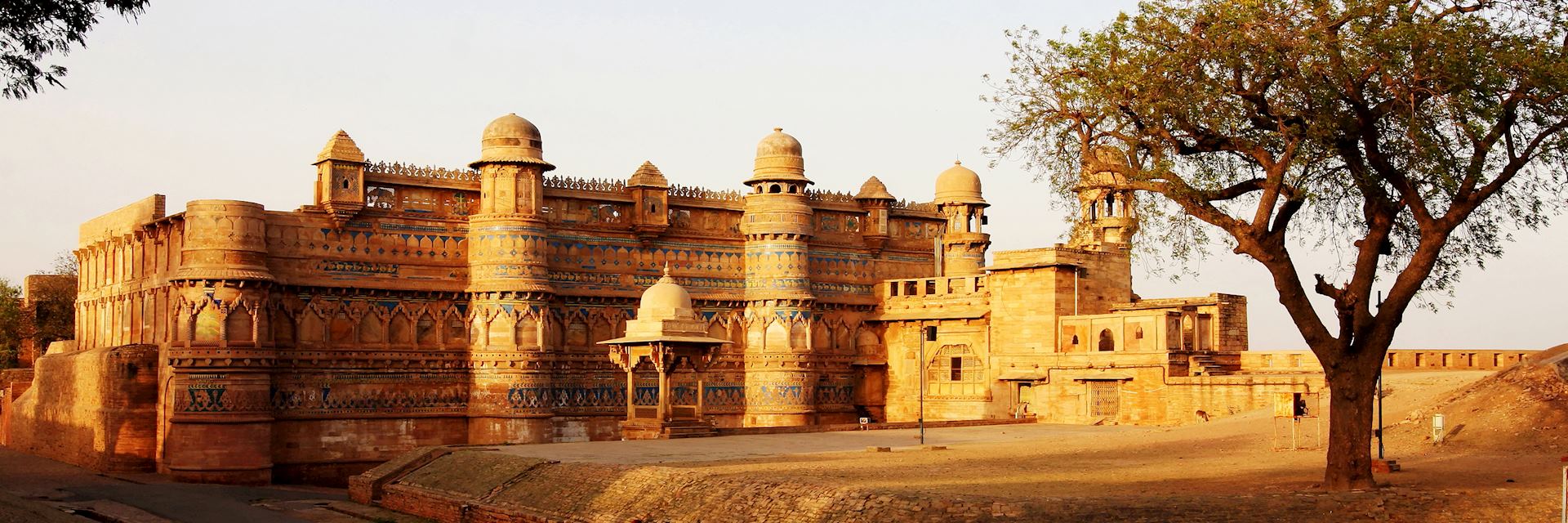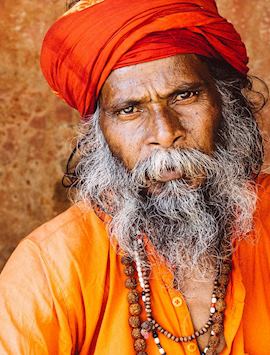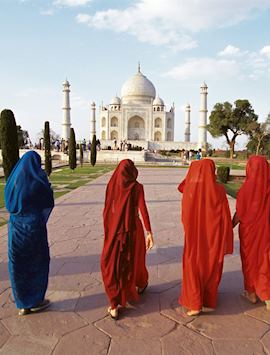By India specialist Katherine
The Golden Triangle has Delhi’s Mughal-era Red Fort, the have-to-visit Taj Mahal, and Jaipur’s lavish palace complex. But, there’s much more to north India than this well-worn trio. You could spend the night in the Thar Desert, take a boat alongside Varanasi’s sacred ghats or admire Khajuraho’s UNESCO-listed carved temples. I’ve picked my highlights of the region, which could expand on a classic Golden Triangle route, or tempt you to uncover a different path entirely.
Jaisalmer and the Thar Desert
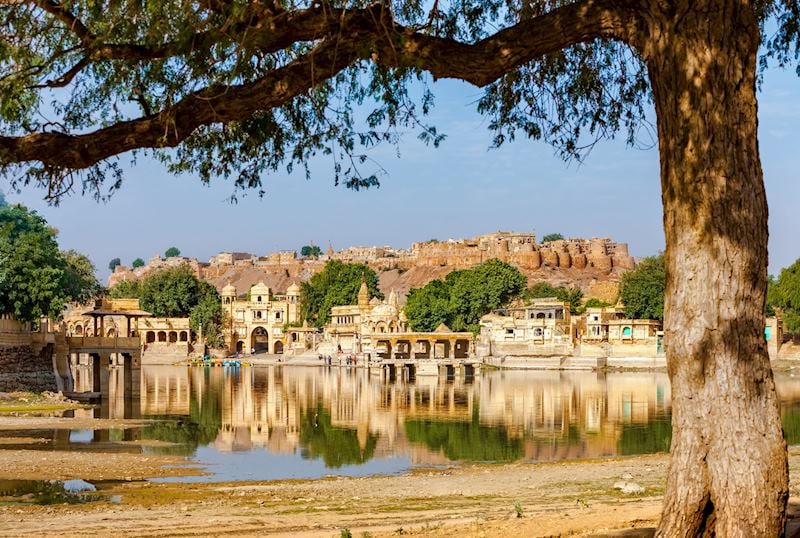
Every city and town in north India seems to have its own fort, so I get a little blasé about these imposing structures. Or, I did until I got to Jaisalmer. Originally, Jaisalmer didn’t ‘have’ a fort — it was the fort. For the better part of the fortress-city’s 800-year history, the entire population lived, worked and worshipped within the sandstone walls.
The city has now breached its original boundary. But, because the fort stands on a hill, its bastions rise well above the modern suburbs. In the early morning, it alone sits above the desert haze, helping you to imagine its initial impact.
The fort can be tricky to navigate, so I suggest taking a guided walking tour. From the outer walls, you follow a wide walkway — designed specifically for camels and horses loaded with goods — that snakes toward the entrance gateway. Once inside, you’ll see children rushing off to school around the corner from the Raj Palace and residents hanging their washing along the 12th-century fortress walls. Occasionally, you’ll hear rhythmic chanting coming from one of the many sandstone temples.
The last Rajput kingdom before India’s western border, Jaisalmer stands on the crossroads of many important trade routes, including the Silk Route. Its isolated location attracts fewer visitors than other Rajasthani cities, but the military airport has recently opened for domestic flights, making it possible to fly in from Jaipur. You could then travel onward to Jodhpur and Udaipur by car.
While there are some hotels within the fort, many are causing conservation concerns due to the pressure they’re putting on the ghut nali (the fort’s historical drainage system). I stayed in Suryagarh, a modern palace-style hotel on the city’s outskirts.
Desert camp stay
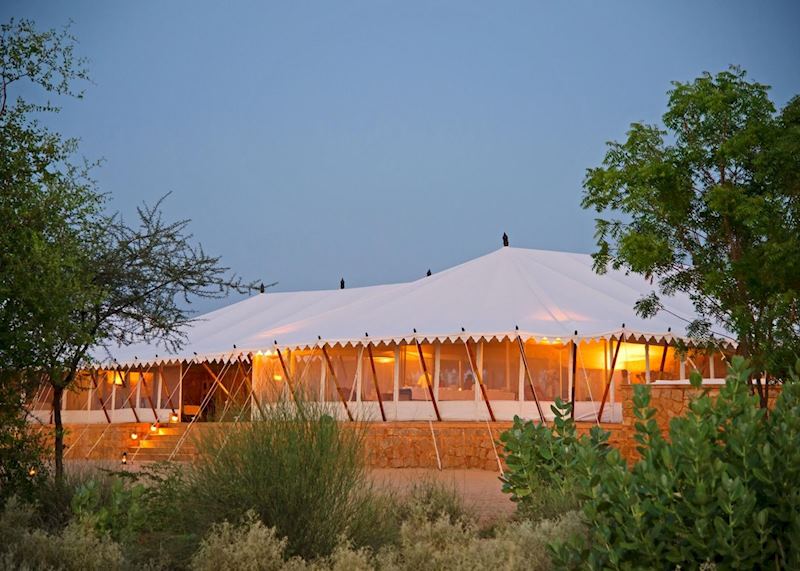

Indian deserts aren’t rows of dunes as far as your eye can see. In Jaisalmer’s Thar Desert, you’ll find pockets of herbaceous scrub, gnarly gum arabic trees and grasslands that shiver with the occasional quail or blackbuck. For me, the best way to experience this environment is to stay in it. You could opt for somewhere like the Serai, a one drive from Jaisalmer, a camp that basically qualifies as a luxury hotel.
Or, for something more akin to past Silk-Route caravans, you can stay at Manvar Desert Camp. A line of white canvas tents arc around a central campfire, each with a running-water bathroom and traditional teak furniture (mimicking the wares that used to be hauled along on the back of camels). From here, I visited some of the nearby desert communities, including the Bishnoi. A religious Hindu sect, their belief in not killing animals is so strict that they check all firewood for insects before burning it.
Bikaner
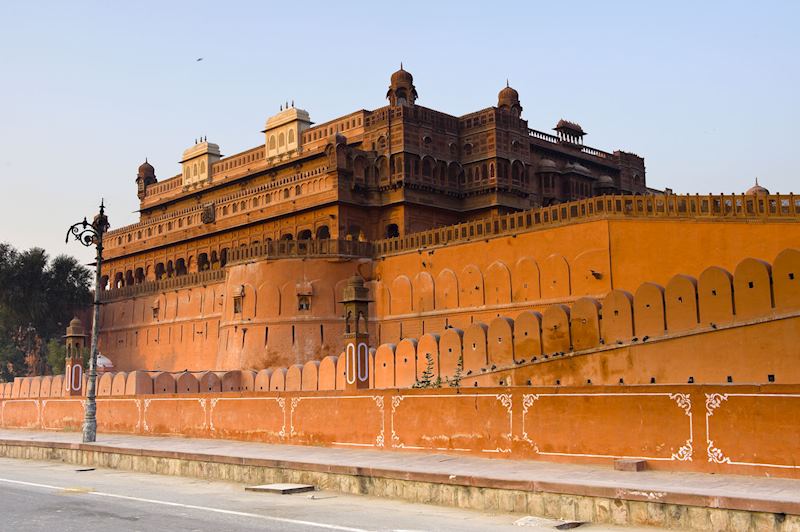
Of the desert fortress cities, Jaipur, Jaisalmer and Jodhpur tend to hog the attention. Built on a smaller scale, Bikaner, in the northwest of Rajasthan, gets overlooked. Another vital oasis on the Silk Route, it has a border-town feel with a dusky sandstone old town surrounded by camel farms. During the British Raj it was the foremost Rajasthan city, with its leader, General Maharaja Ganga Singh, a member of the Imperial War Cabinet and present at the Versailles Peace Conference.
Blending into the skyline, Junagarh Fort is cut from the same desert-ochre stone as the rest of the city. It occupies a relatively flat plot of land and doesn’t have the initial impact of other forts, but don’t judge it too quickly. Stepping inside, I was greeted with some of the most flamboyant tiled floors, glass mosaics and lattice windows I’ve seen in India.
The fort museum is full of gifts from fellow rulers. My guide told me that an aircraft from King George V is somewhere in the palace grounds, a thank you for Bikaner’s help in World War I.
It feels like every second building in Bikaner is a palace, many of which are now hotels. If you want a slice of maharaja-evoking hospitality though, you’d be better staying at Narendra Bhawan. The residence of the last Maharaja of Bikaner, it’s now a contemporary hotel — the sort where dinner appears on a series of tiny tasting plates. I found a rose-petal-filled bath in my room, a mix of modern and heritage Indian design.
Rural Rajasthan
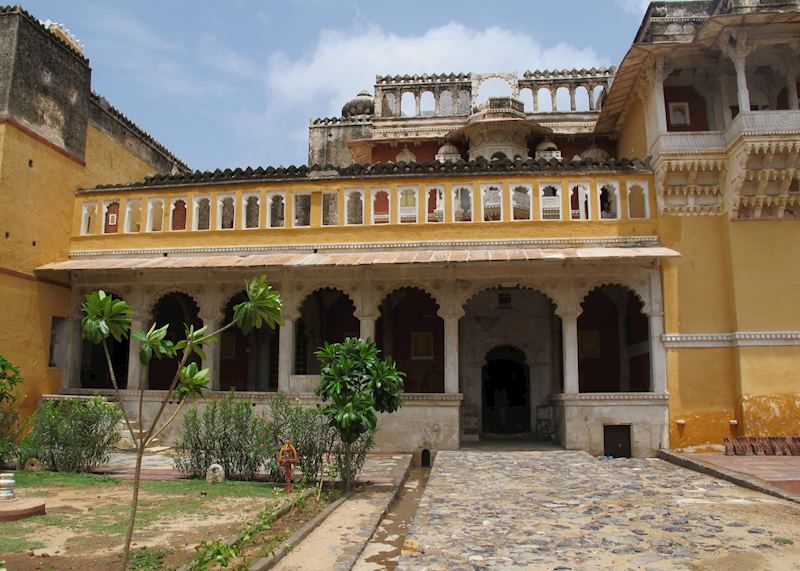
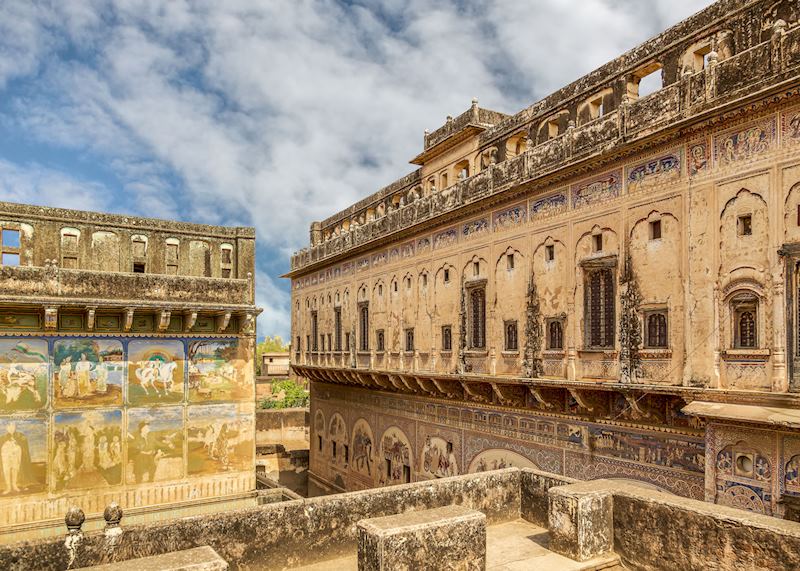
Traditional trips to north India move between large cities. While you can see many of the main attractions this way, you’ll miss out on some of the best experiences. For instance, you could spend time at Ramathra Fort in a tiny village between Agra and Jaipur. Here, you can take a 4x4 ride along the Chambal Valley, a plateau of goat and blue bull herds, visiting the farms and villages.
Midway between Jodhpur and Udaipur, the small family palace of Chanoud Garh has passed down 13 generations and is now in part a hotel (the family still live in one side). In Hindi, garh means house, but it’s now more associated with this type of property dotted across rural Rajasthan, which were usually owned by wealthy merchants, courtiers or army generals.
During my stay, I dined with the family around the barbecue pit. They regaled me with Marigold-Hotel-style tales of refurbishing their home for guests (although, I’d say the result is more luxurious). The following day, I joined them in the village, drinking copious amounts of chai and popping into a temple for a blessing.
One of the most revealing rural stops for me was Mandawa, a tiny town to the west of Delhi that’s on the way to Bikaner. It’s part of the Shekhawati region, a now-defunct political state defined by its richly muraled buildings. As I wandered with my guide, he described the range of artwork we were viewing, from 17th-century folk takes to 20th-century depictions of the visiting colonial British (who were often drawn with a bottle of drink in their hand).
Uttar Pradesh and Madhya Pradesh
After flying into Delhi and visiting Agra and its Taj, you don’t have to continue into Rajasthan. Instead, you could segue southeast into the lesser-visited states of Uttar Pradesh and Madhya Pradesh.
Here, you’ll come into contact with some of the most intricately carved temples in India, centuries-old religious ceremonies and little-visited villages. The drives between the cities and villages are also shorter, and everything runs along to a more relaxed pace.
Gwalior
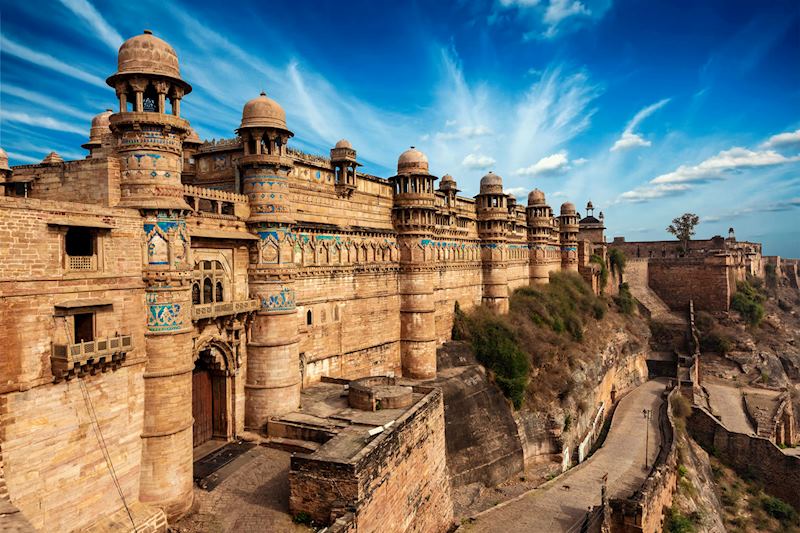
The first city south of Agra, Gwalior is a three-hour drive away through a patchwork of farmland. As you wind your way up to its hilltop fort, you’ll pass a series of Jain statues carved into the rock face in a style more associated with Petra or Egypt. Some date back as early as the 7th century, and one shows one of the oldest written examples of zero. Inside the sandstone fortress you’ll find a confusion of temples, palaces and museums that are best negotiated with a guide.
The Hindu Scindia dynasty ruled the state from the 18th century, building a series of ostentatious palaces. The Usha Kiran Palace was one of their guesthouses for visitors and, as it’s now run by Taj Hotels, you can follow suit. Set in a leaf-dappled garden, it’s an oasis from the dusty city.
Orchha
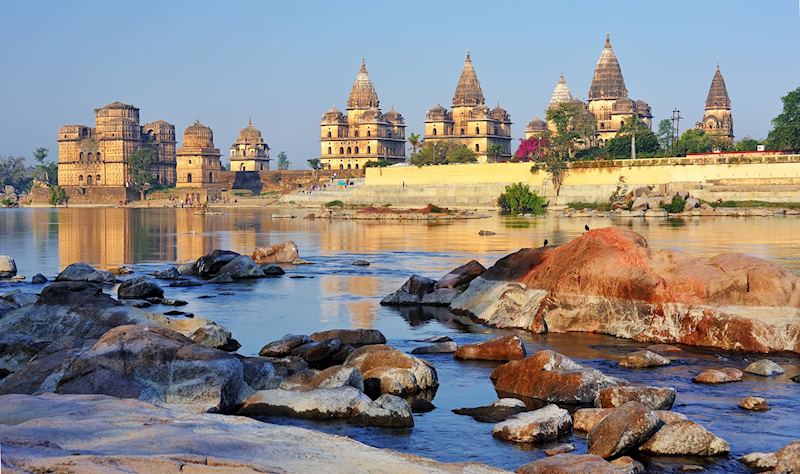
When I last visited this riverside town, I tried to find out if it was pronounced ‘Or-ca’ or ‘Orch-a’, but no-one really seemed to mind. This laid-back attitude reflects on a place that proves a respite from the busier cities. A three-hour drive from Gwalior, the town stands alongside three mahals (palaces) on a rocky promontory above the Betwa River.
You can spend an afternoon here idling around the palaces, chhatris (cenotaphs) and temples. One evening, I visited the Ram Raja Temple, a Hindu pilgrimage site that was originally a palace. Lord Ram (an incarnation of the god Vishnu) is worshipped accordingly here as a king. You can watch the evening salutation ceremony, which blesses holy relics and statues with water to a crescendo of singing.
I suggest staying a night here before you continue for about three hours to Khajuraho the next day.
Khajuraho

Yes, it’s the location of India’s ‘sexiest’ temples. But, the erotic art that attracts visitors to Khajuraho is a small part of a larger story. Built in about 1000 AD by the royal Chandela dynasty, the temples were abandoned in the 13th century in the hope of hiding them from invading Muslim sultans. Only in 1838 did a young British officer, T S Burt, rediscover them while hunting.
I recommend a guided tour, because it can be bewildering to navigate the 22 temples by yourself. There are a variety of schools of thought behind the carvings, but most agree that early Hindu and Jain gurus would encourage devotees to take their senses to extremes. But, as well as an often-acrobatic range of sexual acts, you’ll see carvings of fine food, women putting on makeup, and musicians and potters at work. The images also have a language of their own — my guide pointed out that the specific angle of a head or limb had a particular meaning.
Varanasi
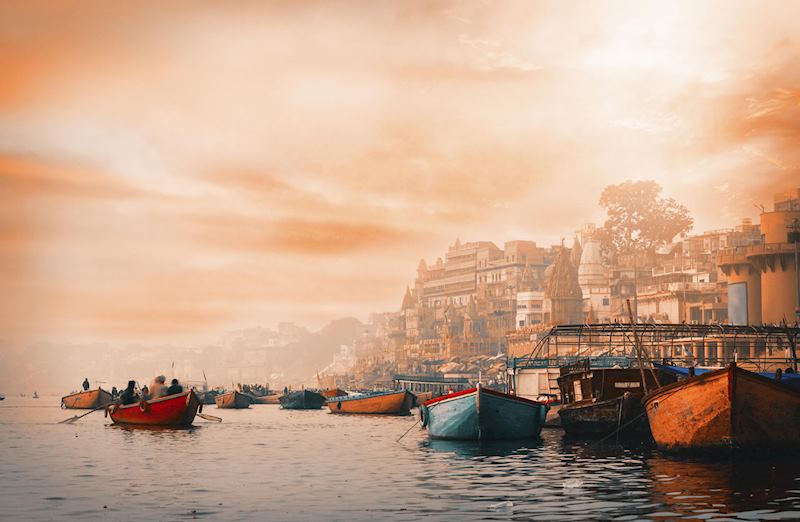
If you’re looking for the very essence of India, in all her chaos and beauty, include a stop in Varanasi. With relatively regular flights from Khajuraho and Delhi, it’s a simple addition that, for me, marks a special ending to a trip across north India. For an end-of-trip treat, stay in BrijRama Palace. Otherwise, opt for the homestay-style Ganges View.
No matter the breadth of your travel credentials, Varanasi can be overwhelming, so I’d use a guide. In what’s considered India’s holiest site, you can join a tour that focuses on death and rebirth, the two key reasons pilgrims come here. You’ll be led away from the main thoroughfares into hidden temples and ashrams, with the opportunity to take part in (or simply watch) some of the ceremonies. When someone dies, my guide told me, the closest relative has their head shaved and dresses in white — details that helped me decrypt what I was seeing as I explored.
Read more about trip ideas to India
Start thinking about your experience. These itineraries are simply suggestions for how you could enjoy some of the same experiences as our specialists. They’re just for inspiration, because your trip will be created around your particular tastes.
View All Tours in India
